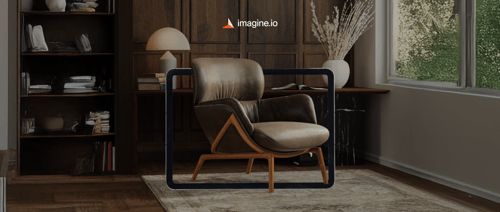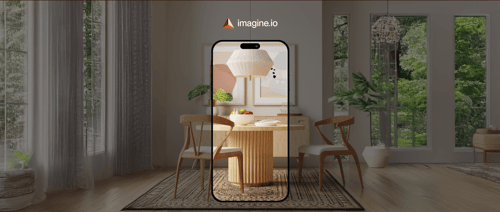CGI revolutionizes home décor retail by offering cost-effective product visualization, faster content creation, and immersive customer experiences that drive sales and engagement.
Quick Listen:
Step into an online furniture store, and a plush, mid-century sofa grabs your attention. You rotate it to admire its curves, switch its upholstery from corduroy to leather, and place it in a virtual living room that mirrors your own. No showroom visits, no pushy sales pitches just you, your device, and a vivid, interactive experience. This is the transformative power of computer-generated imagery (CGI) in home décor retail, where visuals don't just sell products they tell stories. With the global home décor market valued at USD 747.75 billion in 2024 and projected to reach USD 1,097.51 billion by 2032, CGI is helping brands captivate customers in a fiercely competitive landscape. Here's how this technology is redefining retail strategy.
Emerging Trends in CGI for Home Décor
The home décor industry lives and breathes visuals. A single image can spark desire or derail a sale, making CGI a linchpin for innovation. Photorealistic renders have largely supplanted traditional photography, delivering crisp, lifelike images of furniture and accessories without the hassle of physical setups. These digital creations capture every detail down to the weave of a rug or the sheen of a lampshade at a lower cost and faster pace. The home décor market, expected to hit USD 768.5 billion in 2025, is projected to grow at a 4.5% CAGR through 2032, fueled by such advancements.
Augmented reality (AR) and virtual showrooms are pushing boundaries further. Picture a customer using their smartphone to project a virtual dining table into their home, checking how it complements their existing décor. AR tools, powered by CGI, make this possible, giving shoppers the confidence to buy online. Cloud-based rendering also allows retailers to generate high-quality visuals on demand, slashing production times. For global brands targeting diverse markets like the Asia Pacific, which commanded a 45.74% market share in 2024 CGI enables tailored imagery that resonates locally, from sleek urban aesthetics to vibrant, region-specific styles.
These trends align with broader consumer shifts. Demand for sustainable products is rising, and CGI supports this by eliminating the need for physical prototypes. In October 2024, a Bali-based furniture brand, Nusantara Lifestyle, used CGI to craft designs blending modern and rustic elements for boutique villas and hotels, showcasing how the technology marries eco-conscious practices with creative flexibility.
Real-World Applications and Success Stories
CGI's impact shines brightest in its practical applications. Furniture brands are using it to create immersive lifestyle imagery that feels personal. A single chair can be rendered in a cozy farmhouse, a sleek penthouse, or a vibrant family den, all without moving a single piece of furniture. This versatility saves time and resources while helping customers envision products in their own spaces.
Home accessory retailers are also harnessing CGI for interactive experiences. With 360° product viewers, shoppers can explore every angle of a ceramic vase or a wrought-iron mirror, zooming in on textures or finishes. Retail chains are leveraging CGI to roll out seasonal campaigns at scale think holiday-themed displays across hundreds of stores without coordinating costly photoshoots. One retailer, using the imagine.io platform, slashed production timelines by 65%, launching a new collection in weeks rather than months.
The CGI services market, valued at USD 10.5 billion in 2023, is on track to reach USD 31.2 billion by 2033 with an 11.5% CAGR, driven by demand for high-quality visuals across sectors. In home décor, where aesthetics drive decisions, CGI's ability to deliver tailored, engaging content is reshaping how brands connect with customers.
Case Study: Scaling Seasonal Campaigns
Consider a national home décor chain preparing for the holiday season. Traditionally, creating visuals for a winter collection would involve renting studios, hiring photographers, and shipping samples costly and time-consuming. With CGI, the same chain can render festive table settings or cozy bedroom vignettes in days, customizing them for different regions or customer segments. This agility not only cuts costs but also allows brands to pivot quickly in response to market trends.
Challenges in Adopting CGI
Despite its promise, CGI isn't without hurdles. Striking the right balance between realism and brand identity is a delicate act. A render that's too glossy can feel artificial, while one that's too rough may undermine quality perceptions. Retailers must collaborate closely with CGI providers to ensure visuals reflect their unique aesthetic, whether it's minimalist chic or eclectic vibrancy.
Asset management poses another challenge. A single product might require dozens of renders for websites, social media, AR apps, and print catalogs, each with distinct specifications. Keeping these assets organized and consistent demands robust digital infrastructure. Consumer skepticism also lingers some shoppers hesitate to trust virtual images, fearing discrepancies with the physical product. High-quality CGI, with meticulous attention to lighting and texture, is critical to overcoming this barrier.
Yet, these challenges are diminishing as technology evolves. Advances in real-time rendering and AI-driven automation are streamlining workflows, making CGI more accessible and reliable for retailers of all sizes.
Opportunities and Business Impact
The benefits of CGI are transformative. Speed is a major win: new collections can go from concept to market in days, not months, allowing brands to capitalize on fleeting trends. Cost savings are equally compelling. Traditional photoshoots, with their crews, equipment, and logistics, pale in comparison to CGI's efficiency, which eliminates the need for physical setups.
Engagement is where CGI truly excels. Interactive features like AR previews or 360° viewers keep shoppers engaged longer, increasing the likelihood of a purchase. A customer who can virtually place a lamp in their bedroom is far more likely to buy than one scrolling past a static image. CGI also simplifies localization for global campaigns. With the U.S. home décor market projected to reach USD 305.51 billion by 2032, brands can tailor visuals to regional preferences without reshooting a single frame.
Retailers are investing heavily in these technologies. The 2024 Voice of Our Clients research shows that 86% of retail executives are prioritizing AI and generative AI to harness data for insights, from optimizing inventory to personalizing promotions. In home décor, this translates to smarter, visually compelling strategies that drive sales.
A Vision for the Future
The home décor industry stands at a crossroads. As consumer expectations soar and competition intensifies, CGI offers a path to differentiation. Its ability to blend artistry with efficiency is reshaping how brands tell their stories, from photorealistic renders to immersive AR experiences. Looking ahead, the integration of virtual reality (VR) and AI-driven automation promises even greater possibilities think virtual showrooms where customers can redesign entire spaces with a click.
The numbers tell a compelling story: a CGI market soaring to USD 31.2 billion by 2033 and a home décor industry poised for steady growth. For retailers, the choice is clear: embrace CGI to create captivating, efficient, and personalized experiences, or risk being left behind. In a world where visuals are everything, CGI isn't just a tool it's the future of retail storytelling.
Frequently Asked Questions
How is CGI transforming the home décor retail industry?
CGI is revolutionizing home décor retail by replacing traditional photography with photorealistic renders that capture every detail at lower costs and faster speeds. The technology enables interactive experiences like 360° product viewers and AR tools that let customers virtually place furniture in their homes before purchasing. With the global home décor market projected to reach $1.1 trillion by 2032, CGI helps brands create immersive lifestyle imagery and scale seasonal campaigns efficiently across multiple regions.
What are the main benefits of using CGI for furniture and home accessory marketing?
CGI offers three major advantages for home décor retailers: speed, cost savings, and enhanced customer engagement. Brands can launch new collections in days rather than months, eliminating expensive photoshoots and physical setups. Interactive CGI features like AR previews and virtual showrooms keep customers engaged longer and increase purchase likelihood by allowing them to visualize products in their own spaces. Additionally, CGI simplifies global campaigns by enabling easy customization for different regional preferences without reshooting content.
What challenges do home décor retailers face when implementing CGI technology?
The main challenges include balancing realism with brand identity, as renders that are too glossy can feel artificial while overly rough images may undermine quality perceptions. Asset management becomes complex when creating dozens of renders per product for various platforms like websites, social media, and AR apps. Consumer skepticism also exists, with some shoppers hesitant to trust virtual images over traditional photography. However, advances in real-time rendering and AI-driven automation are making CGI more accessible and reliable for retailers of all sizes.
Disclaimer: The above helpful resources content contains personal opinions and experiences. The information provided is for general knowledge and does not constitute professional advice.
You may also be interested in: imagine.io | Award Winning 3D + AI Product Visualization
Struggling with expensive, outdated product visuals that slow down your creative process and stunt eCommerce growth? imagine.io's AI-powered platform empowers furniture, home décor, and textile brands to effortlessly produce striking 3D images, immersive videos, AR experiences, and interactive configurators. Cut production costs up to 70%, boost conversions 5X, speed up prototyping, and supercharge your online sales. Ready to elevate your product visuals and captivate customers? Book a demo with imagine.io today!
Powered by flareAI.co




.png?width=500&name=How%20to%20Add%20a%203D%20Product%20Configurator%20to%20Your%20WordPress%20Website%20(Complete%20B2B%20Guide).png)
















%20(1).png?width=500&name=Why%20Exploded%20Mattress%20Views%20Matter%20(And%20How%20to%20Generate%20Them)%20(1).png)
.png?width=500&name=Best%20Shopify%20Product%20Configurator_%20How%20to%20Choose%20the%20Right%20One%20(2).png)
.png?width=500&name=Why%20Exploded%20Mattress%20Views%20Matter%20(And%20How%20to%20Generate%20Them).png)



.png?width=500&name=Best%20Shopify%20Product%20Configurator_%20How%20to%20Choose%20the%20Right%20One%20(1).png)







.png?width=500&name=How%203D%20Rendering%20Can%20Make%20or%20Break%20Your%20Industrial%20Design%20Pitch%20(1).png)








%20with%20Digital%20Twins%20and%203D%20Visualization.png?width=500&name=Optimizing%20Your%20Digital%20Asset%20Management%20(DAM)%20with%20Digital%20Twins%20and%203D%20Visualization.png)




.png?width=500&name=Styling%20Home%20Decor%20for%202025_%20From%20Global%20Influences%20to%20Playful%20Personalization%20(1).png)
